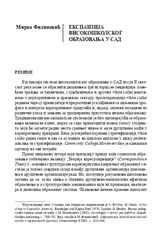Приказ основних података о документу
The expansion of higher education in the USA
Ekspanzija visokoškolskog obrazovanja u SAD
| dc.creator | Filipović, Mirko | |
| dc.date.accessioned | 2021-06-09T13:20:22Z | |
| dc.date.available | 2021-06-09T13:20:22Z | |
| dc.date.issued | 2007 | |
| dc.identifier.issn | 0354-401X | |
| dc.identifier.uri | http://rfasper.fasper.bg.ac.rs/handle/123456789/159 | |
| dc.description.abstract | The expansion of US higher education in the post-World War II period may be explained by the concurrence of three historical tendencies: the expanded demand for technical, clerical and other white collar skills by the corporate and state sector of the economy, the proletarization of the white collar labor, whose privileges and prerogatives are being brought into line with the profit and control objectives of corporate enterprise, and the demand for expanded access to higher education by minority and working class youth. The traditional system of higher education, which was suitable for training an economic elite, was now pressed to accommodate a wave of students who were designated for the middle level of relatively powerless jobs in corporate economy. An increased stratification of the white collar work force was needed and it relied on educational credentials to legitimate the stratification. The Community College Movement was an adequate response to these needs. | en |
| dc.publisher | Izdavačko preduzeće "Socijalna misao", Beograd | |
| dc.rights | openAccess | |
| dc.source | Socijalna misao | |
| dc.title | The expansion of higher education in the USA | en |
| dc.title | Ekspanzija visokoškolskog obrazovanja u SAD | sr |
| dc.type | article | |
| dc.rights.license | ARR | |
| dc.citation.epage | 150 | |
| dc.citation.issue | 4 | |
| dc.citation.other | 14(4): 139-150 | |
| dc.citation.spage | 139 | |
| dc.citation.volume | 14 | |
| dc.identifier.fulltext | http://rfasper.fasper.bg.ac.rs/bitstream/id/308/156.pdf | |
| dc.identifier.rcub | https://hdl.handle.net/21.15107/rcub_rfasper_159 | |
| dc.type.version | publishedVersion |


